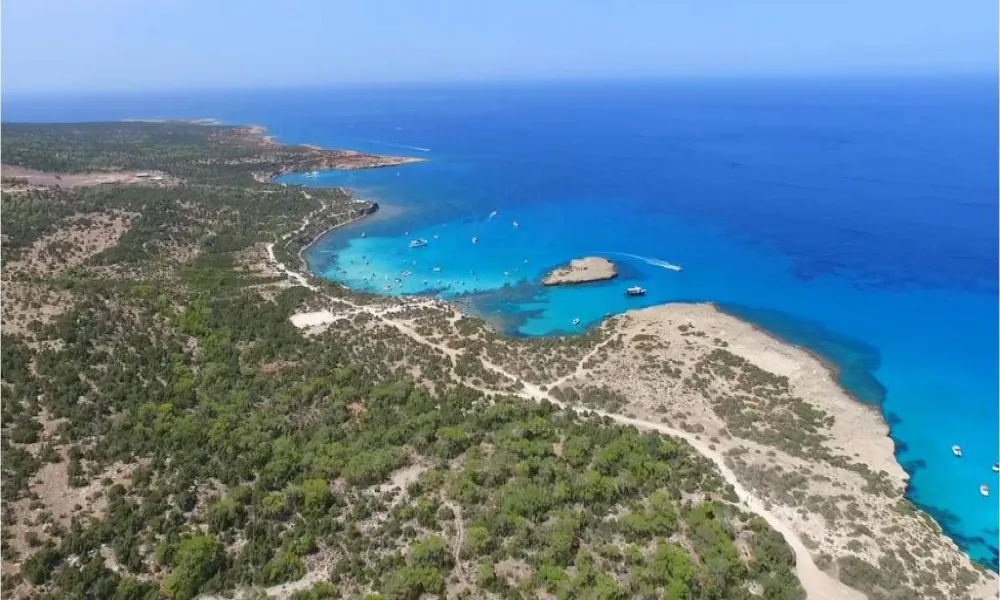Significant work completed in recent months by the Bicommunal Technical Committee on the Environment is now before Nikos Christodoulides and Tufan Erhürman. With a new page turning in the Turkish Cypriot leadership, the two leaders are urged to jointly showcase the progress and move to concrete political decisions.
The Five Pillars
The “green” confidence-building measures (CBMs) are organised around five pillars. Three were agreed by both sides at the informal five-party meeting on Cyprus in Geneva last March: environmental protection, climate change, and impacts in mining areas. Two more were added in July at the informal New York meeting: air-quality monitoring and tackling microplastic pollution. These initiatives address everyday, shared challenges that require cooperation to solve.
Two CBMs Ready for Decision
Two initiatives are considered mature: an island-wide shield against the looming threat of citrus devastation from huanglongbing (HLB), also known as citrus greening; and preparatory work to empty the toxic lakes in the Lefka area, whose waters are used for irrigation of vegetables traded across the Green Line and consumed island-wide. Greek Cypriot co-chair of the committee, Michalis Loizides, describes these as successful actions now ripe for leader-level approval.
Speaking to Politis, Mr Loizides urges both leaders, taking advantage of the momentum from the leadership change, to agree on letting the bicommunal committees operate at full capacity. He calls on Mr Christodoulides and Mr Erhürman to highlight the green CBMs achieved so far and to set clear timelines, specific action proposals, and robust monitoring.
Citrus “Yellow Dragon” Disease (HLB)
Under “environmental protection”, cross-community scientific cooperation on HLB is at an advanced stage. International experts who recently visited Cyprus warned that the disease’s arrival is a matter of time. Its principal vector, the Asian citrus psyllid (Diaphorina citri), is already widespread across Cyprus, first detected in 2023 at Fasouri, Limassol. Notably, Cyprus is the only EU member state where the insect has been detected, and the European Commission is monitoring closely.
The two communities are urged to collaborate so that, when HLB arrives, damage is contained, following examples like California, rather than Florida, where lack of early action led to a 75% collapse in citrus production. The committee’s plant-health experts have agreed to recommend to the leaders a concrete action package that includes:
• Regular field data sharing on a common database managed by the UN Development Programme (UNDP), also logging fast-spreading pathogens affecting other species (e.g., prickly pears, palms, cucurbits, and pines).
• Coordinated chemical control for large citrus groves, limited to EU-permitted formulations.
• Biological control in areas where spraying is unsuitable (yards, pavements, parks) via the release of a jointly accepted parasitoid that preys on the psyllid, avoiding competing releases. Releases have already begun.
Prickly Pear Protection
A similar joint toolkit is being prepared against the prickly-pear mealybug, which coats plants in a cottony mass leading to die-off and drying.
Lefka’s toxic lakes
Under “impacts in mining areas”, a leader-level political decision is needed to remove toxic waters from a one-by-one-kilometre expanse of lakes near Lefka. The former operator, the American CMC, left after the 1974 invasion, leaving heavily contaminated tailings ponds. Poor construction has led to annual overflows and leaching into the aquifer; produce irrigated with this compromised water is then sold across Cyprus via Green Line trade.
According to Mr Loizides, a 20-year removal project is ready to start: Turkish Cypriot and Greek Cypriot firms stand prepared to transport and treat the water, with mountain routes mapped to minimise disturbance to residents. What remains is a political go-ahead from the two leaders. The committee has also agreed to build a shared platform mapping all quarries and inert mines across Cyprus, with essential site data.
Safeguarding the cypriot honeybee
Beyond plant diseases, “environmental protection” also covers preserving the native honeybee subspecies Apis mellifera cypria. Naturally more irritable and defensive due to its long struggle with the predatory eastern hornet (Vespa orientalis), the Cypriot bee faces genetic dilution as foreign bee stocks are increasingly imported. The subspecies is being displaced, threatening biodiversity. The committee has indications that only about 25% of bees in the north remain of the Cypriot line, with similar trends in the south. Four meetings have been held on the topic, with actions to promote the native strain up next.
Wild dog packs
Also under environment: growing packs of feral, free-breeding dogs are appearing within communities such as Kampi and Tsakistra. Over the past 6–7 years there have been attacks on people and deaths of mouflon. The issue is present in other parts of the Paphos Forest and Lefka area. An island-wide feral dog population around 200,000 is estimated. As these animals cannot simply be caged, the committee is discussing a large fenced area for relocation. Invasive fish will also be addressed soon under the same pillar.
Climate change and new themes
For climate change, the sides will build a shared database on land-vulnerability cases, consolidating datasets. The two newer themes are:
• Air-quality monitoring: a platform to alert the other side to smoke types (wildfire or industrial stack malfunction) crossing the buffer, so communities know what they are breathing and when to evacuate if needed.
• Microplastics: a coordinated effort to manage microplastics detected in wastewater treatment plants across Cyprus, which are currently returned to land with sludge.
With technical work advanced and joint frameworks in place, the moment is primed for leader-level decisions. Endorsing these green CBMs with timelines, funding clarity, and accountability can deliver immediate, shared benefits, and rebuild confidence through practical problem-solving on a common island.
